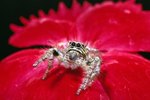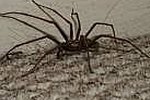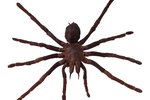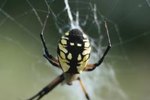
A violin. The number eight. The infinity symbol. Anything resembling these shapes of two adjacent circles on the body of a spider should raise alertness, as it could be the extremely poisonous brown recluse spider. However, take other factors such as location, eye placement and size into consideration to prevent a wrong identification.
Violin Shape Identification
While other spiders may have circular brown markings, only the brown recluse has a distinct violin shape on its body. However, it may be quite difficult to distinguish it. For the brown recluse, this violin shape is usually dark brown on a lighter brown body, with the shape imposed on the cephalothorax of the spider. Though often known colloquially as the stomach of the spider, the cephalothorax is right between the head and bigger abdomen of the spider, and is the part of the body onto which the spider’s legs attach. Meanwhile, the neck of this violin shape should point to the back of the spider.
Habitat
It is easy to misidentify violin shapes on spiders or otherwise mistake all brown spiders for recluses. Thus, you should find out if you are actually in an area where these spiders live in the first place. You can check a local map to be sure, but generally, the brown recluse spider lives throughout the South and Midwestern United States, covering states like Kansas, Missouri, Louisiana, Missippi, Alabama, Tennessee, Oklahoma, southern Illinois, and parts of eastern Texas. Outside of these areas, brown recluses are rarely found.
Other Identifying Marks
Brown recluses are about the size of a U.S. quarter with legs extended, and about 3/8 inch in body length. Their legs are uniformly light-colored and have no stripes or other marks. Closer up, while most spiders have eight eyes in two rows of four, brown recluses have six eyes arranged in pairs, with one pair in front and a pair on both the left and right sides. Meanwhile, its body is of a uniform light or dark brown color, with no markings. Spiders commonly mistaken for brown recluses include the cellar spider, which also has a darkened area on its cephalothorax, or the pirate spider, which has cephalic markings as well. Both these spiders, however, have eight eyes instead of six.
Precautions
In areas where brown recluses are native, they are usually found in dark, secluded areas. Outdoors they may live under rocks, logs and other wood debris. Indoors they are commonly found in corners or other hidden places, like behind furniture, and generally do not come out in daylight. Thus, spider webs built out in the open usually do not belong to brown recluses. However, these spiders may come out and wander into shoes, clothing or bedding at night. If you live in an area with recluse spiders, be careful when moving furniture or searching for objects in dark, dusty areas of the house; also try to keep shoes, clothes and other clutter off the floor.
Bites
While brown recluses have a fearsome reputation, they are actually quite gentle spiders and usually won’t bite unless they somehow become trapped against bare skin. While most brown recluse bites heal within three weeks, some people may react to the venom by developing skin sores that end up destroying surrounding tissues. In the latter case, seek medical attention immediately, though these symptoms could also arise from bacterial infections. If you think you may have been bitten by a brown recluse spider, try to trap or at least squash the spider right after being bitten to bring for expert identification.
References
Resources
- Brown Recluse Spiders; Eric Ethan
Photo Credits
-
Comstock Images/Comstock/Getty Images
Writer Bio
Lei Line has been writing about health, science and technology since 2009, primarily in Asia. She has a bachelor's degree in environmental studies.




